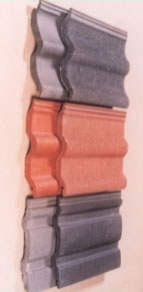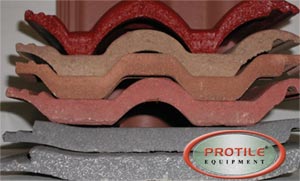 |
Guide to Roof Tile Manufacturing |
| |
Raw materials |
Concrete roof tiles provide an aesthetically pleasing, affordable, durable roof for life. The materials used in their manufacture are sources locally.
River sand is mixed with a clean finer pit sand to provide the correct sand grading before 42.5MPa Portland cement is added and mixed with water. Colour is obtained by adding various coloured synthetic iron oxide pigments at the mixing stage at around 3% of cement mass.
The wet mix is then fed into the "tile extrusion machine", which extrudes the concrete into the required shape onto an aluminium pallet, which has already been sprayed with a pallet release agent. Water ratios in the mix are normally around 8.5% depending on the aggregate quality.
The wet tile is then cured overnight, in heated curing chambers for at least 8 hours at very high humidity of +90% RH and +42°C temperatures.
After curing the dry tile is then separated from the aluminium pallet so that the pallet can be re-used for every shift in the tile extrusion process.
The dry tile can either be directly stacked in the yard or first coated with and acrylic coating if required. If this occurs a further drying process is necessary before stacking the tiles.
|
|
|
| |
| |
Process |
| |
Tiles can be produced in a variety of luxurious colours and surface finishes.
Colouring and finishing techniques can be acheived by:
-
Adding oxide pigments to the mixer.
-
Applying a coloured polymer coating to the tile surface.
-
Applying coloured cement slurry.
-
Adding coloured granules to the tile surface.
 From top to bottom:
From top to bottom:
Asymmetrical, Double Roman, and Double Flat Tile Profiles
|
 From top to bottom:
From top to bottom:
Tuscan, Bold Double Roman, Double Flat, Double Roman, and Shingle
|
|
|
|

